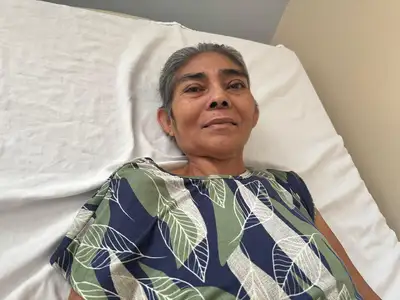Ovarian cancer: the silent enemy that challenges diagnosis
With the absence of characteristic symptoms in the early stages, the disease is one of the most aggressive neoplasms among women

At 53 years old, fisherman Rosineth Basto, a resident of the municipality of Curralinho in the Marajó archipelago, is facing a struggle already experienced by other generations of her family. Cancer, which claimed her father and sister, has also affected other close relatives, revealing a family history marked by the disease. A mother of two children, she discovered that her ovary was compromised in 2024 after experiencing severe abdominal pain.
The absence of characteristic symptoms in the early stages means that the malignant neoplasm takes time to be detected. As a result, approximately 80% of cases are identified only in more advanced stages. When the disease progresses, the main symptoms are increased abdominal volume, difficulty eating, pelvic abdominal pain, menstrual changes, and excessive urination.

“It started with very strong pains. I went to the hospital on the island, they did an ultrasound and found that I had a tumor, already a bit advanced.” Shortly after the diagnosis, Rosineth was referred for treatment at the Ophir Loyola Hospital (HOL), a reference in oncology in Pará. “The doctor evaluated everything, I did all the tests and it turned out to be ovarian cancer. He operated, removed the tumor, and I spent six months undergoing chemotherapy,” she reported.
Rosineth began to feel pain again and returned to the hospital, where new tests detected three tumors in her intestines. “They operated again, removed the tumors. Now I am in recovery and just waiting for the surgery to heal to be discharged,” she said.
Considered the third most frequent gynecological neoplasm by the National Cancer Institute (Inca), ovarian cancer is only behind cervical and endometrial cancer. The disease predominantly occurs in postmenopausal women and is the eighth most incident malignant tumor, according to the Ministry of Health (MS). For each year of the triad from 2023 to 2025, 7,310 new cases are expected in Brazil, which corresponds to an estimated risk of 6.62 new cases for every 100,000 women.
In the Northern region of the country, the estimated risk by the MS is 3.61 new cases for every 100,000 women, ranking seventh in the table of the federation states. In Pará, from January 2023 to April of this year, the Ophir Loyola Hospital received 379 women affected by the disease, from different ethnicities and ages.
A notable case worldwide is that of American actress Angelina Jolie. With a family history of cancer on her mother's and grandmother's side, the actress is affected by a mutation in the BRCA1 gene, a type of tumor suppressor gene that plays a crucial role in DNA repair. To prevent the development of the disease, the artist removed both her ovaries and breasts in 2015. As explained by HOL oncologist Danielle Feio, other factors should prompt female vigilance.

“Ovarian cancer is a very aggressive disease. It usually appears in women over 50, but it can occur in younger women. Therefore, it is important to pay attention to smoking, obesity, endometriosis, nulliparity (absence of children), and family history of cancer. So, if I could leave a message for women, it would be: if you have never had children or are over 50, visit the gynecologist annually and request a transvaginal exam. Early diagnosis saves lives. Everything that is diagnosed early has a higher chance of cure,” emphasized the specialist.
According to the Ministry of Health, mutations in the BRCA1 and BRCA2 genes and in cell cycle control are observed in up to 15% of patients with ovarian cancer. One of the greatest difficulties regarding ovarian cancer is detection in the early stages. Before the definitive diagnosis, Rosineth reports having been treated for fibroids, but believes that the disease was already present. “I had a fibroid operation, but they did not do a biopsy to confirm. Four months later, the pain returned with more intensity,” she said.
Some tests help identify the presence of cancer cells in the ovary, such as the tumor marker CA-125. Transvaginal ultrasound, computed tomography, and magnetic resonance imaging (which analyze the presence of masses and the extent of the disease), chest X-ray or CT scan (which identify pulmonary metastases), biopsy, and other gynecological exams are also indicated.
Service: To be referred to the Ophir Loyola Hospital, the patient needs to be referred through the regulation system by the Basic Health Unit or the Health Department of the municipality of origin.
*Text by David Martinez, under the supervision of Leila Cruz









